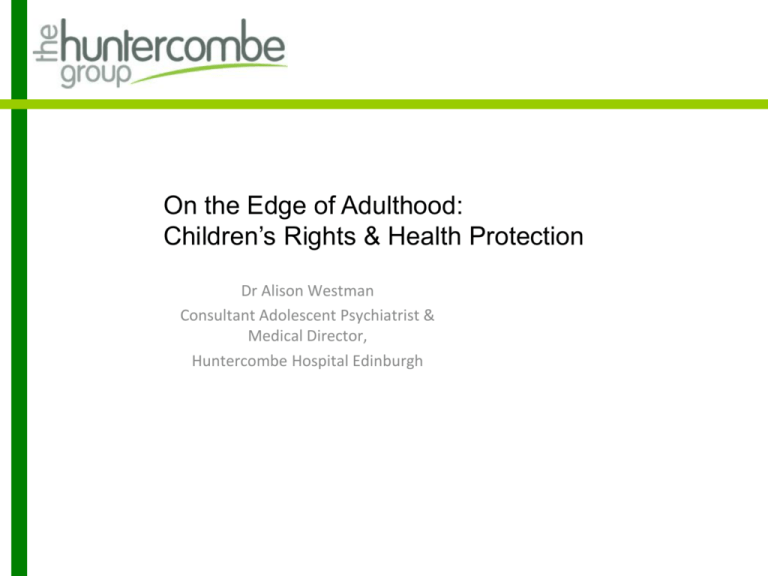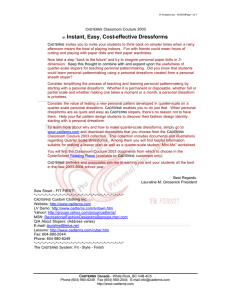Children's Rights and Health Protection: Dr Alison
advertisement

On the Edge of Adulthood: Children’s Rights & Health Protection Dr Alison Westman Consultant Adolescent Psychiatrist & Medical Director, Huntercombe Hospital Edinburgh Children & Young People’s Rights • Children’s rights & adolescents’ rights in health services • UNCRC – Protection from harm – Prevention of discrimination – Participation in decisions – Provision of the essentials for survival & development Protection from Harm Unmet need – What is important about adolescence and identifying and meeting health needs of adolescents? – Does policy development support this? – How do service structures enable professionals to meet the need? Protection from harm “The effects of poor health during the teenage years can last a lifetime. Keeping adolescents healthy is a valuable investment in the nation’s future” (Chief Medical Officer’s report, England, 2007). Protection from harm • Sir Ian Kennedy’s Report ‘Getting it right for children and young people’, described teenagers as • “… ’a forgotten group’, caught between child and adult, and therefore between bureaucratic barriers and professional spheres of influence” (p38). • “One of the main cultural obstacles for young people is the lack of recognition of them as distinctly different from children as well as adults ......” Kennedy Ian (2010) Getting it right for children and young people; Overcoming cultural barriers in the nhs so as to meet their needs. Adolescent health in the UK today: Update 2012 • Why encourage a specific focus on adolescent health? – Increased risk – Long-term benefits for the individual – Long term benefits for everyone – Information needs – Service development needs Hagell A, Coleman J (2012) Adolescent health in the UK today: Update 2012. Association for Young People’s Health Adolescent health in the UK today: Update 2012 , Hagell A, Coleman J (2012) Adolescent health in the UK today: Update 2012. Association for Young People’s Health Protection from harm: Mental health needs • Challenging period of development & change in all areas of functioning. Protection from harm: Impact of Policy • Longer term themes – – – – – Health inequalities Transition from paediatric to adult services Focus on outcomes Young people’s participation in their own healthcare Young people’s participation in service development: Cultural shift & legislative requirements for involvement of young people • Central Government Departments: Framework of core principles for involvement of young people across depts; Action Plans required from all depts to evidence this; increasing access to information (websites, reports of consultations). • Central Government & Local level: expectation of ‘routine’ involvement in service development Protection from harm: Impact of Policy • Recent policy developments: – Restructuring within health services, including: • Children & Young People’s Outcome Board, led by the Chief Medical Officer, • A new Children & Young People’s Health Outcome Forum. – Relevant policy statements about adolescent health included: • “Achieving equity and excellence for children” (2010), the Coalition Government’s response to the Kennedy review on children and young people’s health. • ‘Improving Children & Young People’s Health Outcomes: a system wide response’ (2013), the Coalition Government’s response to the Children & Young People’s Health Outcome Forum Report (2012). – IAPT (Improving Access To Psychological Therapies) Prevention of Discrimination: Special Groups • Young people with learning disability: – UN Convention on the Rights of Persons with Disabilities (UNCRPD) – Integrated CAMHS; In-patient services • • • • • Young people with other disability – hearing loss Looked after children Adolescents from BME communities Asylum seekers Young offenders – increased levels of mental health need; increased risk of learning difficulties. • Transitions to adult services – Managing to ensure continuity of care; Change in emphasis – individual & family; social and emotional needs; from education to occupation. – ADHD; emerging Personality Disorder; enduring & severe mental health problems. Participation in Decisions • • • • Participation Confidentiality Autonomy Consent Participation in Decisions • Participation – – – – – In decisions regarding their care In the quality of services received In the development of services By being informed; giving an opinion; being able to influence a decision; having authority to be the main decider. • Requires: – access to mechanisms that allow them a voice, – provision of and need for accessible information – Identification of factors which prevent or facilitate children's participation. Franklin A, Sloper P (2005) Listening & Responding? Children’s participation in health care within England. International Journal of Children’s Rights 13. ½, 11-29 Participation in Decisions • Consent – 16-18 year olds – presumed competent to consent unless evidence to contrary – If not competent, decision-making moves to person with parental responsibility – person with parental responsibility may request access to medical records but competent child must consent. – Under 16 years – not automatically deemed to be competent to consent to treatment but may assume such responsibility if capacity assessed. – However, even a legally competent adolescent may have decision to refuse treatment over-ruled by parent. • Gillick Competency/Fraser Guidelines • Mental Capacity Act for over 16 years olds Participation in Decisions • Barriers to Participation: – Implications of traditional views about children’s status and concerns about adult/child relationships; children’s lack of power – Complexity & bureaucratic nature of organisations – Adult attitudes towards capabilities & competence of children; protection of children – Lack of training & research evidence to promote participation – Lack of time, resources, funding – Young people themselves – attitudes towards adults; lack of confidence; lack of resources (eg, transport); other competing priorities. Franklin A, Sloper P (2005) Participation in Decisions • Factors that facilitate participation: – Clarity & shared understanding – Staff training & development – Using flexible & appropriate methods • Using multi-media approaches & other methods; resources such as communication aids, interpreters; use of advocates, mentors; gaining familiarity through multiple contacts; flexibility over ways children communicate; independent facilitators supporting confidentiality; making participation fun & rewarding. (Cavet & Sloper, 2004) – Organisational culture & systems • Listening culture; commitment. – Assessing & evidencing the impact of participation Franklin A, Sloper P (2005) Mechanisms to facilitate participation • Improving Children & Young People's Outcomes (2013): – Modernisation health & social care – local emphasis – Bodies identified as having specific roles in pursuing best interests of children & young people include: • NHS CB (Commissioning Board; Public Health England – establishes local health & wellbeing boards; • NHS Trust Development Authority; • Health Education England; • Healthwatch England – appointment of leading children’s advocate, Christine Lenehan as a co-chair; local Healthwatch organisations; • DH; Clinical Reference Groups; CQC; Mechanisms to facilitate participation • Specific initiatives involving children – CQC consultation over 3 year strategic direction & involvement in consultation activity; – Support from DH for ‘You’re Welcome’ Participation in Decisions • You’re Welcome – Quality Criteria for local areas to: – involve young people in service improvement – enhance patient experience – increase young people’s opportunity to share in decisions about their health – Summary of 10 themes • Access; Publicity; Confidentiality and consent; Environment; Staff training, skills, attitudes and values; Joined-up working; Involvement in monitoring and evaluation of patient experience; Health issues for young people; • Sexual and reproductive health services; Targeted and specialist CAMHS Mechanisms to facilitate participation • Criticisms: – Focus of change and development is not specific for young people – Services appear more fragmented and locally based; ? more competition – What will be the impact of changes on equality in outcomes & safeguarding? – What will be the overall impact for young people? Provision of Essentials for Survival & Development • Access to services able to respond to all levels of need (mild, moderate & severe) – – – – Developmentally appropriate and approachable services Location Availability & resources Professional training • Transition from Children’s Services to Adult • Responses: Integration & Partnership – e.g., government, central & local; statutory & nonstatutory; other providers; professional bodies. Tiers of service for young people with mental health difficulties Provision of Essentials for Survival & Development • Mental Health Provision: – Structures are available & under constant development. – Difficulties: • • • • • High level of demand – 10-20% of the adolescent population Waiting times can be long; threshold for access increased Training of professionals not always adequate Difficult to make complaints Services are being cut because of reductions in budgets State of Children’s Rights Report (2012) In conclusion… • There is a lot happening that is very positive and shows: – awareness of the importance of young people’s health; – positive efforts to facilitate their involvement and effective participation at Central Government and local levels and welcoming other stakeholders; – and to provide necessary mechanisms • But… – That tends to be in the context of grouping young people with children, or families, or all ages. – Mechanisms are numerous and diverse; joining up processes to demonstrate effective outcomes & make the process rewarding and reinforcing for young people will be extremely difficult. – Economic conditions & budgetary restrictions leading to service constraints.







